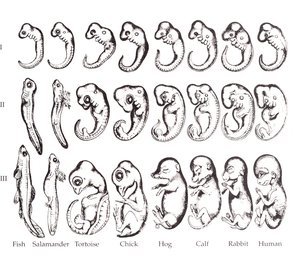Embryo drawings
|
|
The term embryo drawings refers to illustrations of embryos. In particular, the term often refers to a specific series of embryo drawings produced by Ernst Haeckel, with the aim of comparing embryos of different classes. These drawings are discussed herein.
| Contents |
History

In 1866, Ernst Haeckel claimed that members of all vertebrate classes pass through identical embryonic stages. To illustrate this, he published drawings of embryos of various species (human, rabbit, calf, hog, chick, tortoise, salamander, and fish), suggesing that the early stages of embryonal development are nearly identical for all of these classes. Haeckel argued that this was evidence for the theory of common descent in discussions of biological evolution, and also used his drawings to propound his now-discredited recapitulation theory.
Recapitulation theory suggests that each successive stage in the development of an individual represents one of the adult forms that appeared in its evolutionary history.
Several studies in the past century have shown that while embryos of different classes certainly show similarities in their early stages, there are also differences. It has been suggested that Haeckel deliberately "fudged" his drawings in order to de-emphasize the differences, thus providing better evidence for his arguments. It has also been suggested that Haeckel simply made a mistake.
Some creationists have used biologists' rejection of the literal recapitulation theory as evidence against evolution. However, biologists and evolutionists generally hold that while recapitulation theory is discredited, this does not affect the credibility of the biological evolution theory. This is because the former is based upon the latter, therefore evidence against the former does not necessarily have any bearing on the latter. While there are accepted differences in embryonal stages across classes, there are also many similarities, which have been used as evidence in support of common ancestry. It is generally accepted that species with a common ancestor pass through similar, but not identical, stages in their embryonal development (see ontogeny and phylogeny).
Place in textbooks
Haeckel's drawings have been reproduced in a wide range of textbooks. In 2000, Harvard University professor Stephen Jay Gould commented on the continued use of Haeckel's embryo drawings in textbooks. He wrote: "We do, I think, have the right to be both astonished and ashamed by the century of mindless recycling that has led to the persistence of these drawings in a large number, if not a majority, of modern textbooks."
Modern textbooks usually contain photographs to show the similarities in embryo development among related species, and these similarities, such as gill-like structures, are still seen as evidence of the common ancestry of humans and fish.
See Also
External links
- Haeckel, E. 1899. Riddle of the Universe at the Close of the Nineteenth Century. Cited at http://www.ucmp.berkeley.edu/history/haeckel.html.
- Division of Biology and Medicine, Brown University, Evolution and Development I: Size and shape, http://biomed.brown.edu/Courses/BIO48/30.S&S.HTML
- Richardson, M. K. 1995. Heterochrony and the phylotypic period. Dev. Biol. 172: 412 - 421.
